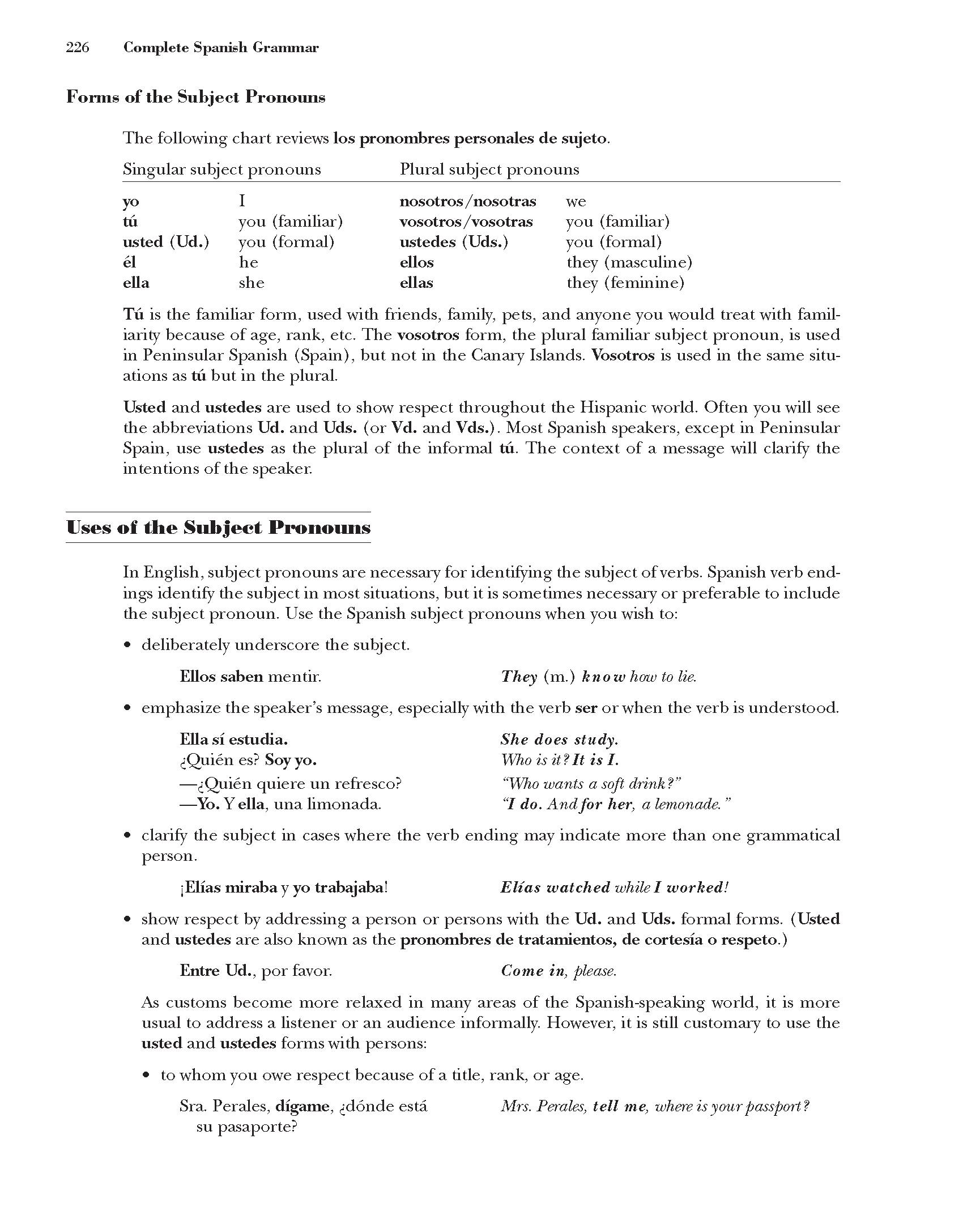CSG237

226 Complete Spanish Grammar
Forms of the Subject Pronouns
The following chart reviews los pronombres personales de sujeto. Singular subject pronouns Plural subject pronouns
yo
tu
usted (Ud.) el
ella
I
you (familiar) you (formal) he
she
nosotros / nosotras yosotros / yosotras ustedes (Uds.) ellos ellas
we
you (familiar) you (formal) they (masculine) they (feminine)
Tu is the familiar form, used with friends, family, pets, and anyone you would treat with famil-iarity because of age, rank, etc. The yosotros form, the plural familiar subject pronoun, is used in Peninsular Spanish (Spain), but not in the Ganary Islands. Vosotros is used in the same situ-ations as tu but in the plural.
Usted and ustedes are used to show respect throughout the Hispanic world. Often you will see the abbreyiations Ud. and Uds. (or Vd. and Vds.). Most Spanish speakers, except in Peninsular Spain, use ustedes as the plural of the informal tu. The context of a message will clarify the intentions of the speaker.
Uses of the Suhjeet Pronouns
In English, subject pronouns are necessary for identifying the subject ofyerbs. Spanish verb end-ings identify the subject in most situations, but it is sometimes necessary or preferable to include the subject pronoun. Use the Spanish subject pronouns when you wish to:
• deliberately underscore the subject.
Ellos saben men tir. They (m.) know how to lie.
• emphasize the speaker’s message, especially with the verb ser or when the verb is understood.
Ella si estudia. She does study.
<:Quien es? Soy yo. Who is it ? It is I.
—<:Quien quiere un refresco? “Who wants a soft drink?”
—Yo. Y ella, una limonada. I do. And for her, a lemonade. ”
• clarify the subject in cases where the verb ending may indicate morę than one grammatical person.
i Elias miraba y yo trabajaba! Elias watched while I worked!
• show respect by addressing a person or persons with the Ud. and Uds. formal forms. (Usted and ustedes are also known as the pronombres de tratamientos, de cortesia o respeto.)
Entre Ud., por favor. Co me in, please.
As customs become morę relaxed in many areas of the Spanish-speaking world, it is morę usual to address a listener or an audience informally. Howeyer, it is still customary to use the usted and ustedes forms with persons:
• to whom you owe respect because of a title, rank, or age.
Sra. Perales, digame, Monde esta Mrs. Terałeś, tell me, where is your passport?
su pasaporte?
Wyszukiwarka
Podobne podstrony:
CSG017 6 Complete Spanish GrammarOther Uses of the Present Tense The present is also used: • &
CSG019 8 Complete Spanish GrammarIrregular Verbs in the Present Tense Many Spanish verbs do not foll
CSG215 204 Complete Spanish Grammar Morę About the Uses of Definite Articles in Spanish The definite
CSG225 214 Complete Spanish Grammar • Adjectives of nationality (gentilicios) that end in -o drop th
CSG033 22 Complete Spanish Grammar 4. She wraps the gift. _ 5. S
CSG119 108 Complete Spanish Grammar 3. I have described the scene to my neighbor R
CSG207 196 Complete Spanish Grammar • names of rivers, seas, and oceans. El rio Mississippi esta en
CSG321 310 Complete Spanish Grammar • Cień indicates the number, quantity, or amount before mil and
więcej podobnych podstron